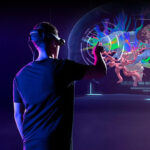Augmented Reality : The retail industry has experienced unprecedented changes during the aftermath of the Covid-19 pandemic. The physical stores had to turn into digital ones for consumers. Although consumers valued the convenience of online buying, it soon became certain that these digital alternatives had their share of drawbacks too. As a result, brands began utilizing various technologies to replicate the in-store experience online. One effective way to do this is Augmented Reality (AR), which, in addition to removing e-commerce restrictions, would improve the experience of online buying by offering thorough product descriptions.
What is Augmented Reality (AR)?
Augmented Reality is a technology of incorporating digital components into the physical world to create a Live experience or view with the help of a camera. AR works in conjunction with headsets and/or digital devices such as smartphones. This technology shows how the product will look when placed in its setup.
AR has been successful in obtaining positive feedback from consumers and over some time, has even gained a great deal of recognition and acclaim from the public. For instance, according to a study by Deloitte, 94% of consumers are anticipated to use Augmented Reality (AR) for shopping this year in the same way they did in 2021. In another survey, it was found that brands that offer AR experiences are 41% more likely to be considered by consumers.
The Emergence of Social Commerce
 /
/
Due to the prevalence of social media, retail trends like social commerce are also rising. Social commerce is the ability to sell products and services directly through social media.
Social reviews and comments significantly influence consumers because of the possible risks involved with online shopping, which has led to a culture of scrutiny and live peer reviews.
Since consumers are more likely to believe in influencers than the brand itself, the former is collaborating with the latter to create a social commerce narrative that takes consumers from discovery to conversion.
Real-time try-on with Snap’s Shopping Lens technology is part of AR’s role in assisting users with their purchasing decisions. Further, creating an immersive AR experience that presents multiple products from a catalogue through one lens. Catalog-Powered AR Lenses allow brands to get immediate results in the real-time popularity of their goods and services as well as consumer feedback.
Although AR lenses come in various shapes, sizes, and designs, they all have in common: they all enhance reality with digital overlays. AR lenses have evolved in the last ten years from outrageously expensive, bulky, and experimental to being covert and incredibly useful. Even while it would be a stretch to call any brand of AR lenses inexpensive, the price has decreased significantly. Competition is anticipated to drive innovation and design while also continuing to drive down costs as new businesses enter the market.
Conclusion
/
In the end, augmented reality-enhanced social commerce will take over as the industry norm for both large retailers and niche brands looking to stand out and engage with customers. As a result, they will be able to mimic in-store experiences and improve the post-purchase experience with guided assistance for product assembly, troubleshooting, and basic repairs, among other things, thanks to AR capabilities. Using Augmented Reality (AR) in social commerce is unquestionably a shrewd business decision that organizations like Lacoste, MAC Cosmetics, Champs Sports, Dior, Gucci, and others have previously adopted with impressive results.




